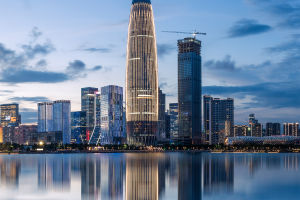Countries across the globe boast unique and stunning cityscapes and architectural wonders. Below, we explore some renowned international cities and their iconic structures:
1. The Forbidden City in Beijing: As one of the world's largest ancient palace complexes, the Forbidden City stands as the imperial palace of the Ming and Qing dynasties in China, serving as a prominent landmark in Beijing. Its striking red walls, yellow tiles, magnificent halls, and intricate gardens epitomize the essence of ancient Chinese architecture.
2. The Eiffel Tower in Paris, France: The Eiffel Tower is an iconic landmark in Paris, France, renowned worldwide. Designed by Gustave Eiffel and completed in 1889, this colossal iron structure offers breathtaking panoramic views of the city.
3. The Colosseum in Rome, Italy: Known as the Colosseum or the Flavian Amphitheatre, this ancient architectural marvel stands proudly in Rome, Italy. Constructed in AD 70, the colossal oval-shaped amphitheater is widely recognized as one of the most illustrious Roman structures globally.
4. Statue of Liberty, New York, USA: The Statue of Liberty graces Liberty Island in New York City, USA, symbolizing freedom and democracy. This bronze statue, towering approximately 46 meters high, was gifted to the United States by the French people and has become an emblematic representation of New York City.
5. Kinkaku-ji Temple, Kyoto, Japan: Situated in Kyoto, Japan, Kinkaku-ji Temple is a renowned Buddhist temple, celebrated as one of the country's most famous. Its top is adorned with gold leaf, and the reflection of the temple's golden pavilion in the surrounding pond creates a captivating spectacle.
6. Burj Khalifa in Dubai, United Arab Emirates: Burj Khalifa stands as a soaring super-tall skyscraper in Dubai, United Arab Emirates, ranking among the tallest buildings globally. Reaching a staggering height of 828 meters, its summit offers awe-inspiring vistas of Dubai's magnificent cityscape.
7. Sydney Opera House, Australia: The Sydney Opera House is an iconic structure in Sydney, Australia, and one of the world's most distinguished performing arts centers. Its distinctive design, inspired by seashells, attracts countless visitors daily, eager to explore its architectural brilliance and witness captivating performances.
The aforementioned examples merely scratch the surface of the world's diverse cityscapes and architectural gems. Each country and city possesses its unique culture, history, and architectural styles, inviting individuals to embark on immersive journeys and indulge in a kaleidoscope of enriching experiences.
The presence and development of cityscapes and buildings in various countries offer numerous advantages, including:
1. Cultural Heritage Preservation: Urban landscapes and architecture, as national and regional cultural heritage, embody profound historical, artistic, and architectural significance. By safeguarding and preserving these structures, countries can perpetuate their distinctive cultural identity and showcase the richness of their history to future generations.
2. Tourism and Economic Development: Prominent cityscapes and architectural wonders attract a substantial influx of tourists and travelers. Tourism plays a pivotal role in the economic prosperity of many countries and cities, generating employment opportunities and driving economic growth. Visitors revel in the unique landscapes, architectural styles, and cultural ambiance of cities, thereby stimulating the development of local service industries, hotels, restaurants, and more.
3. City Image and Promotion: Cityscapes and landmark buildings significantly contribute to shaping a city's image and fostering global recognition. Captivating cityscapes and distinctive architecture capture the world's attention, projecting a positive image of the city and enhancing international reputation and prominence. This factor proves pivotal in attracting foreign investments, propelling urban development, and facilitating cultural exchanges.
4. Community Cohesion and Sense of Identity: Iconic buildings and landscapes foster a sense of identity and pride among local residents. These unique architectural landmarks serve as shared symbols, uniting communities, strengthening social bonds, and nurturing a sense of belonging.
5. Urban Planning and Sustainable Development: Cityscapes and architecture wield considerable influence over urban planning and sustainable development efforts. Preserving historical buildings while developing new landmark structures allows for the creation of a visually appealing cityscape and optimized spatial layout, ultimately enhancing the aesthetic appeal and living standards of the city. Moreover, sustainable urban design principles and construction techniques foster environmental conservation and resource efficiency.
In conclusion, the benefits of cityscapes and architecture in various countries encompass the preservation of cultural heritage, tourism, and economic development, city image and promotion, community cohesion and sense of identity, and urban planning for sustainable development. Collectively, these factors contribute to the prosperity and growth of cities, offering a wealth of experiences and opportunities for residents and visitors alike.


